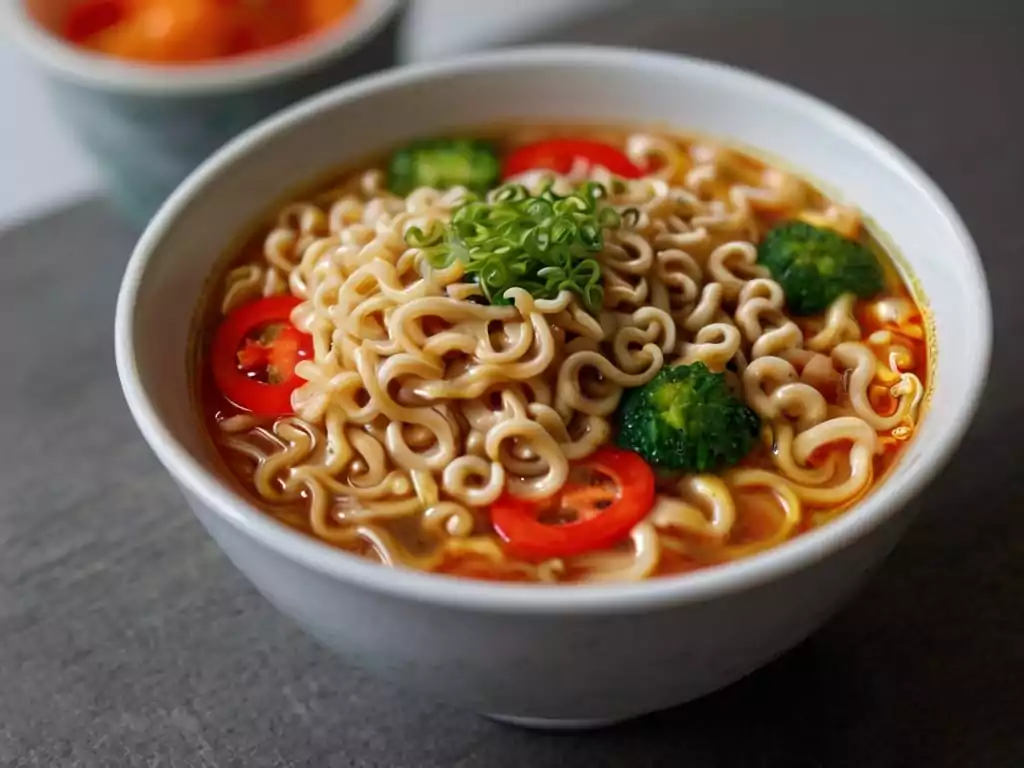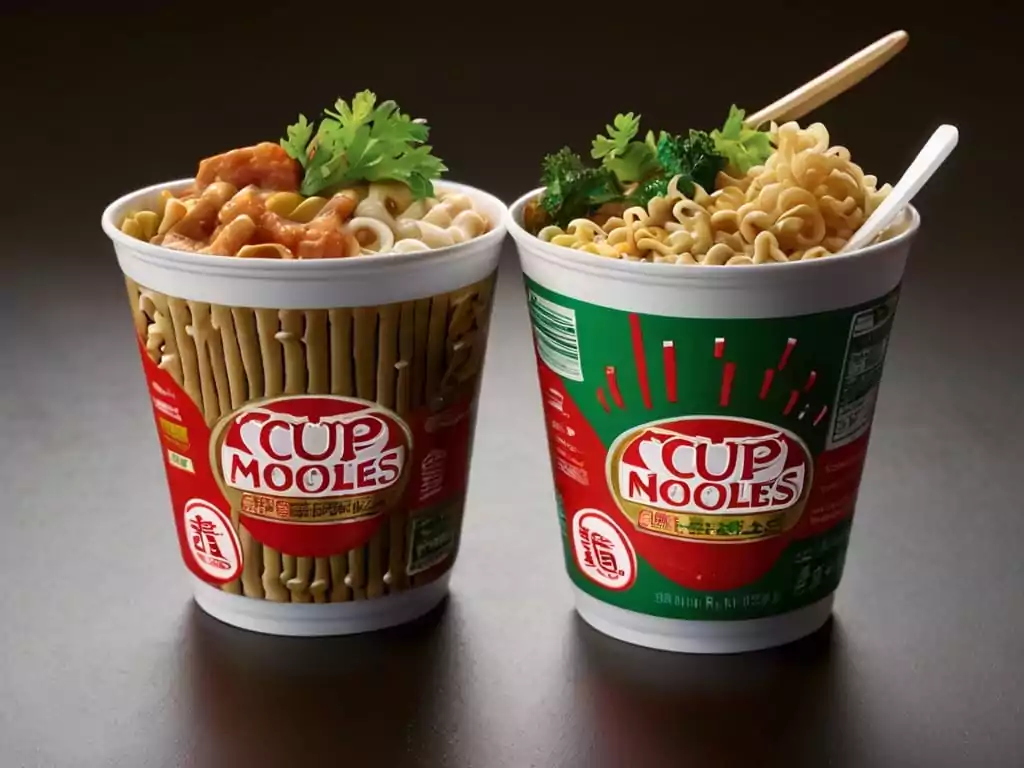Introduction to Cup Noodles
Brief History of Cup Noodles
Once upon a time, in the bustling streets of Japan, a food revolution was brewing. The year was 1971, and the world was about to be introduced to a game-changer in the realm of quick meals – the first-ever cup noodles. Invented by Momofuku Ando, the mastermind behind instant ramen, these noodles weren’t just a hit; they were a culinary upheaval. Packaged in a waterproof polystyrene cup, cup noodles offered convenience, taste, and an answer to the hunger pangs of millions, all wrapped up in one.
The Global Impact and Popularity
Fast forward to today, and cup noodles have become nothing short of a global phenomenon. From Tokyo to New York, these instant noodles have found their way into the hearts (and stomachs) of people from all walks of life. Why, you ask? Well, for starters, they’re the epitome of convenience. Boil water, pour, wait, and voilà – a steaming hot meal ready in minutes. But it’s not just about ease; it’s the sheer variety that has folks hooked. Whether you’re a fan of chicken, beef, shrimp, or vegetarian options, there’s a cup noodle flavor out there with your name on it.
Moreover, their popularity isn’t just confined to the realm of quick eats. Cup noodles have become a cultural icon, featuring in movies, art, and even fashion. They’re not just food; they’re a lifestyle – a symbol of modern life’s hustle and bustle, where convenience is king.
So, as we peel back the lid on this culinary marvel, let’s dive into the broth of history, innovation, and cultural impact that has made cup noodles a beloved global staple. Stay tuned, because this journey is just getting started, and trust me, it’s going to be a flavorful ride.

The Evolution of Cup Noodles
Early Beginnings and Invention
The tale of cup noodles begins with a spark of innovation in post-war Japan. The inventor, Momofuku Ando, observed long queues of people waiting for a simple bowl of ramen at local stalls. This sight sparked an idea: what if noodles could be prepared quickly and easily at home? And so, after much trial and error, the first instant noodles were born in 1958. However, it wasn’t until 1971 that Ando revolutionized the industry again by introducing cup noodles to the world. This wasn’t just a new product; it was a new way of eating noodles – faster, easier, and with a variety of flavors to boot.
Innovations and Variations Over the Years
Since their inception, cup noodles have undergone a whirlwind of transformations. Initially, the options were somewhat limited, focusing on basic flavors like chicken, beef, and shrimp. But as their popularity soared, so did the variety. Today, you can find cup noodles in an array of exotic flavors and styles, catering to local tastes and international palates alike. From spicy kimchi in Korea to creamy tom yum in Thailand, the evolution of cup noodles reflects a journey of culinary exploration and innovation.
Moreover, the innovation didn’t stop with flavors. The packaging itself has seen upgrades, including microwave-friendly cups and eco-conscious materials. The brands behind these noodle cups have also introduced variations with lower sodium content, whole grain noodles, and even vegan options, making cup noodles more accessible to health-conscious consumers and those with dietary restrictions.
This evolution from a simple cup of instant noodles to a diverse and adaptable food product showcases the ingenuity behind cup noodles. It’s a testament to how a simple idea can grow and adapt, finding its place in the ever-changing landscape of global cuisine.
The journey of cup noodles is a fascinating tale of innovation, adaptation, and global influence. From their humble beginnings to becoming a staple in pantries around the world, cup noodles have proven that convenience and flavor can go hand in hand. As we continue to explore the multifaceted world of cup noodles, it’s clear that their evolution is far from over. With each new flavor, packaging innovation, and dietary adaptation, cup noodles continue to redefine what it means to enjoy a quick, delicious meal. So, here’s to the ongoing journey of cup noodles – a journey that promises even more surprises and delights for noodle lovers everywhere.
Understanding the Production Process
Diving into the world of cup noodles, it’s not just the flavors and convenience that capture our fascination, but also the intricate ballet that unfolds behind the scenes. Yes, I’m talking about the production process. This isn’t your average kitchen cook-up; it’s a meticulously choreographed dance that transforms simple ingredients into the cups of joy we’ve all come to adore. So, let’s pull back the curtain and peek into the fascinating journey from flour to flavorful feast.
Ingredients Commonly Used
At the heart of every cup noodle, there’s a symphony of ingredients playing together in harmony. The main star, of course, is the wheat flour, which is the canvas for this edible art. But what’s a painting without colors? That’s where the palm oil, salt, and the magic of seasoning come in, adding depth and character to each bite. And let’s not forget the veggies – freeze-dried peas, corn, and carrots that spring to life with just a splash of hot water.
Step-by-Step Manufacturing Process
- The Noodle Symphony Begins: It all starts with mixing and kneading the wheat flour with water and salt, creating a dough that’s both elastic and sturdy. This dough is then rolled out and cut into thin, noodle-like strands, ready for their transformation.
- A Steamy Affair: Next up, the noodles are steamed at high temperatures, a process that cooks them just right, ensuring that they retain their texture and taste when rehydrated.
- The Flavor Tango: While the noodles are cooling off, they’re bathed in a savory sauce, soaking up all the umami goodness. This step is crucial, as it’s where the noodles get their distinctive flavor that dances on your taste buds.
- A Quick Tan: After their flavor spa, the noodles are then air-dried or flash-fried, a step that not only gives them their long shelf life but also creates that irresistible texture that we all love.
- The Veggie Parade: Remember those veggies we talked about? This is where they make their grand entrance, along with any meat or seafood pieces, all freeze-dried to preserve their freshness and taste.
- Packing the Punch: Finally, the noodles and their flavorful companions are packed into their iconic cups, sealed with a lid, and ready to make their journey to your pantry.

Quality Control and Packaging
But wait, there’s more! Before these cup noodles hit the shelves, they go through a rigorous quality control process. Every batch is tested for taste, texture, and safety, ensuring that what you get is nothing but the best. The packaging isn’t just about looking pretty; it’s designed to keep the contents safe and fresh, from the factory to your fork.
So, there you have it, folks – a sneak peek into the world of cup noodles production. It’s a process that marries tradition with technology, quality with convenience, ensuring that every cup not only satisfies your hunger but also brings a smile to your face. Now, every time you peel open a cup, remember the journey it’s been on, and savor not just the taste, but the craftsmanship and care that went into making it.
Analyzing the Nutritional Content
In the whirlwind tour of cup noodles, it’s easy to get swept up in the convenience and taste. However, as we pivot to a more health-conscious lens, it’s crucial to dissect what exactly is nestled within these cups of quick cuisine. Yes, cup noodles are the epitome of convenience, but let’s take a moment to sift through the nutritional nitty-gritty, shall we?
Nutritional Breakdown of Typical Cup Noodles
At first glance, cup noodles might seem like just a quick fix to curb hunger. But diving deeper, we find a mix of nutrients that can both fuel and falter, depending on your dietary goals. A standard cup typically packs a punch with carbohydrates, given its wheat-based noodle core, making it a high-energy food. Protein levels can vary, often depending on the flavor and the addition of meat or seafood bits.
However, the plot thickens with the sodium content, which often skyrockets, making cup noodles a less ideal choice for those monitoring their salt intake. Fats, too, especially saturated fats from the fried noodles and flavorings, can be a concern for heart health.
Health Considerations and Dietary Concerns
For the health-conscious, the nutritional profile of cup noodles might raise eyebrows. The high sodium and saturated fat content can contribute to increased blood pressure and heart disease risk over time. Yet, not all is doom and gloom. Many brands have introduced lower-sodium, reduced-fat, and even whole grain options to cater to a health-aware audience.
Moreover, the addition of vegetables, albeit in small and freeze-dried form, does offer some vitamins and minerals. It’s a small win, but in the grand scheme of nutrition, every bit counts.
